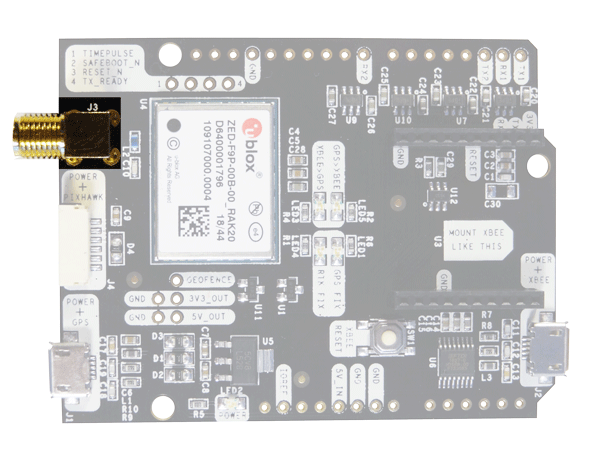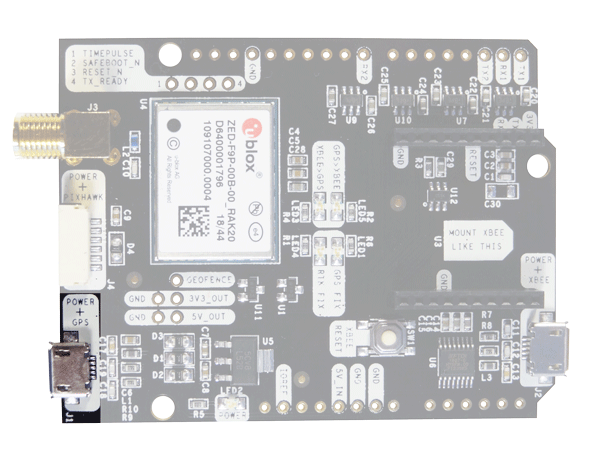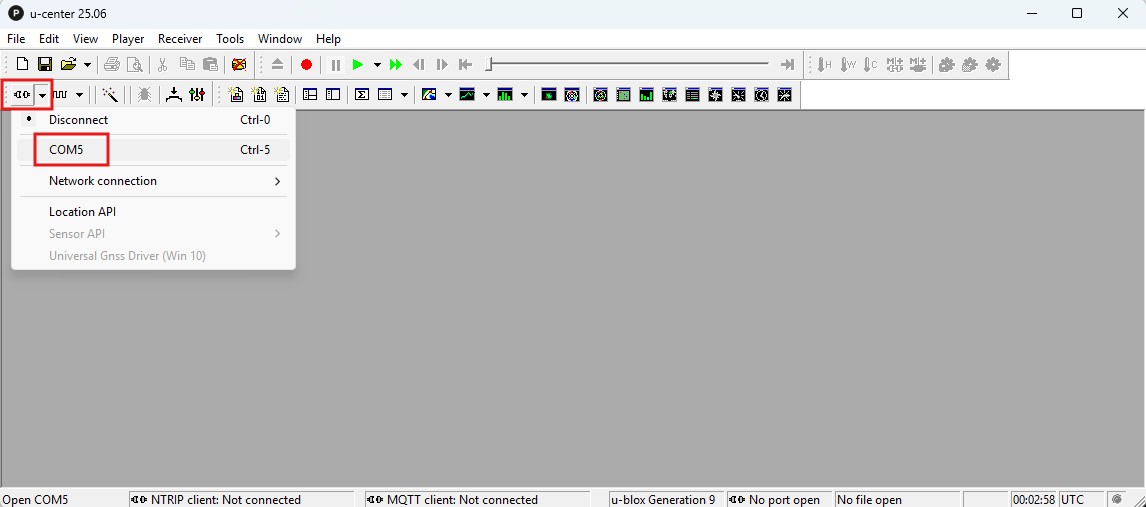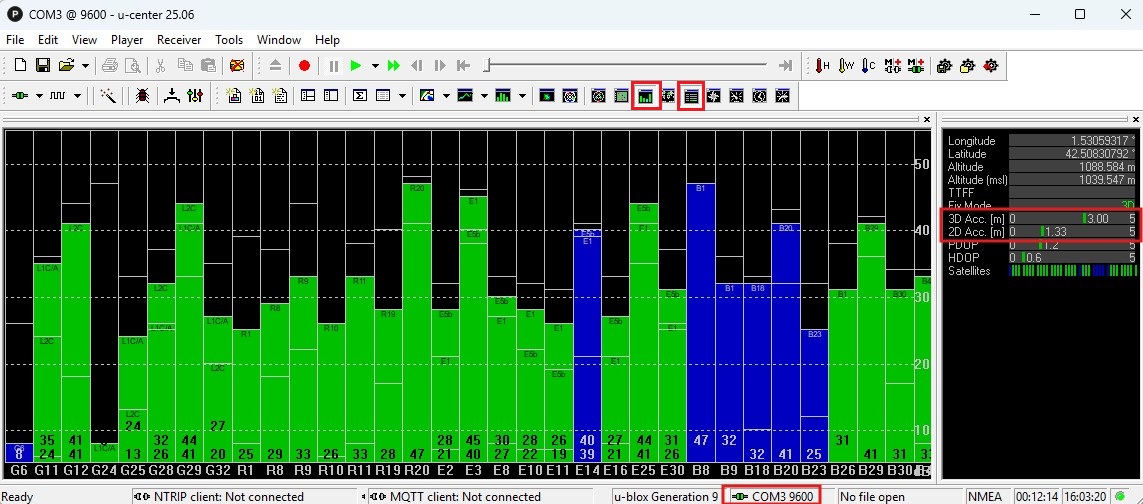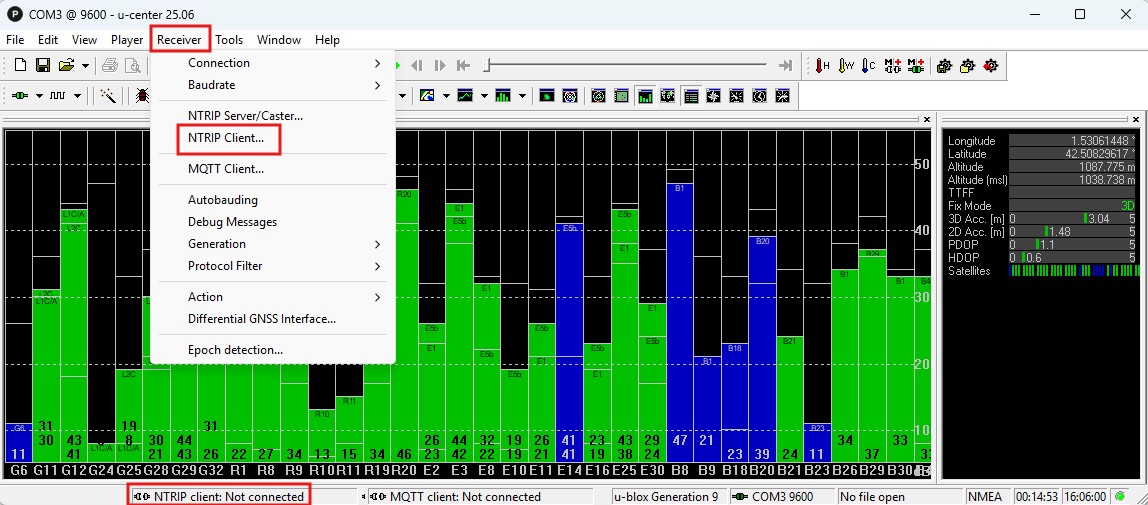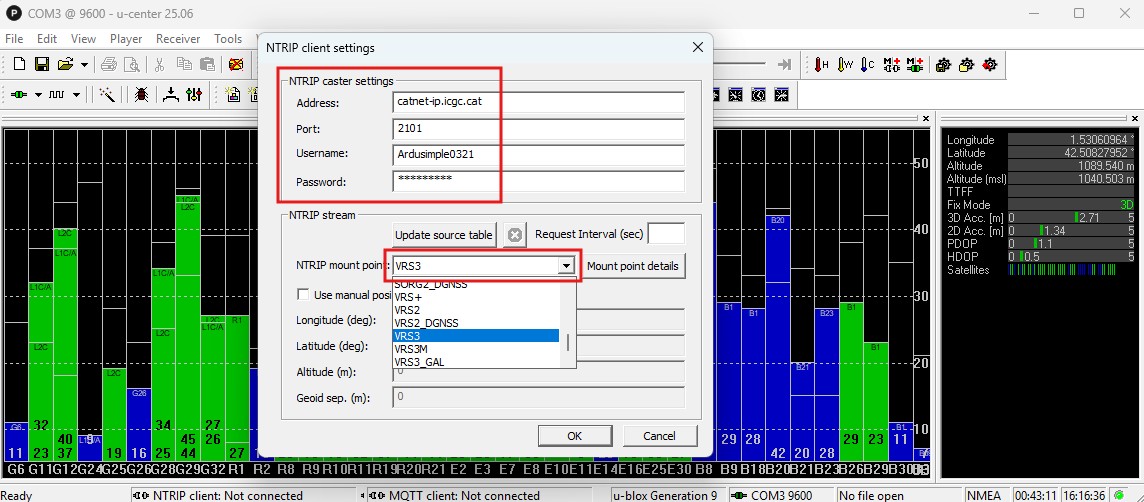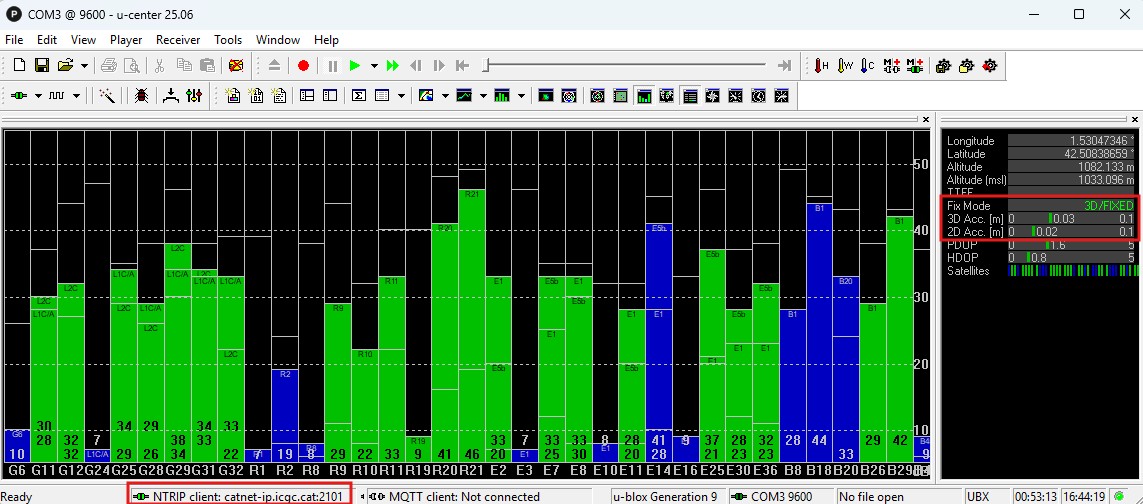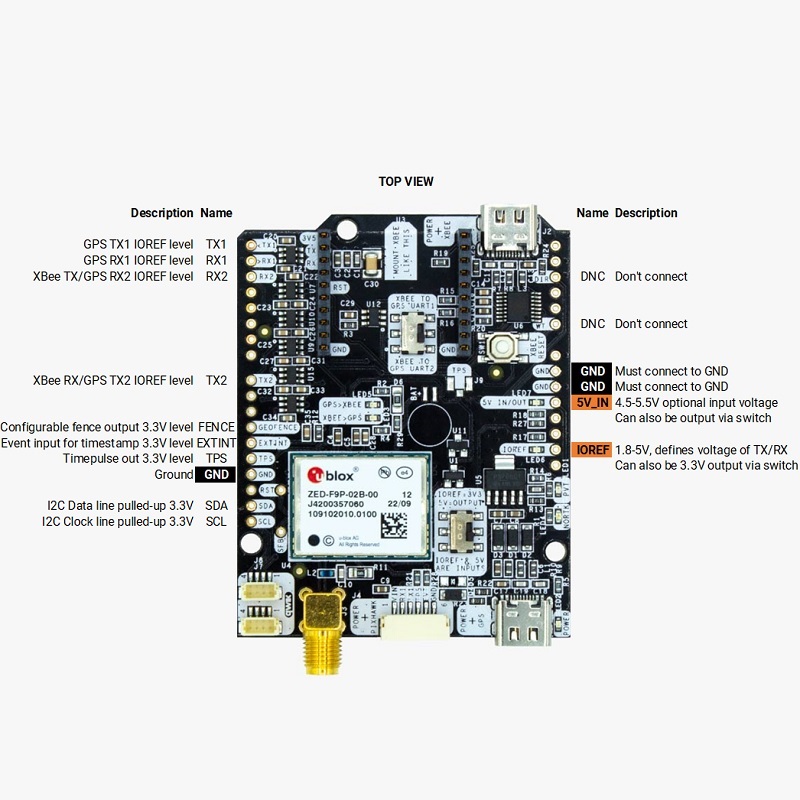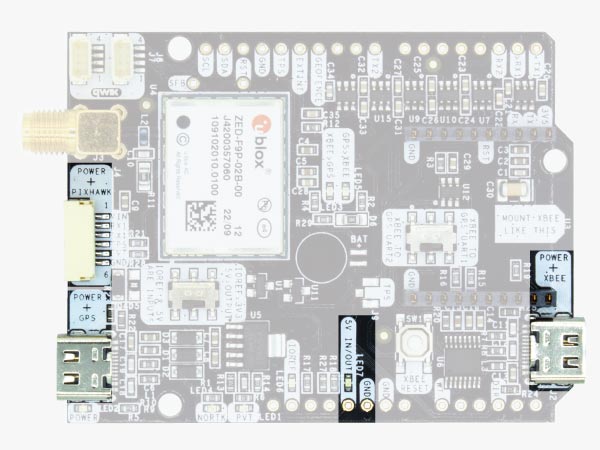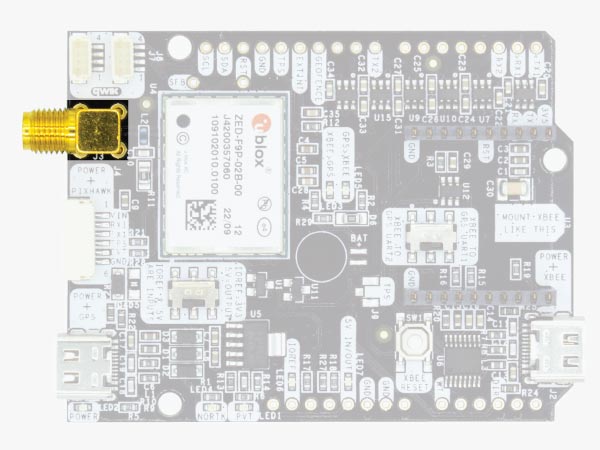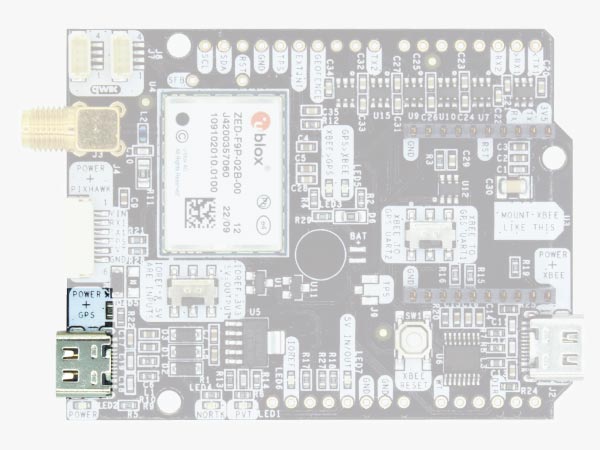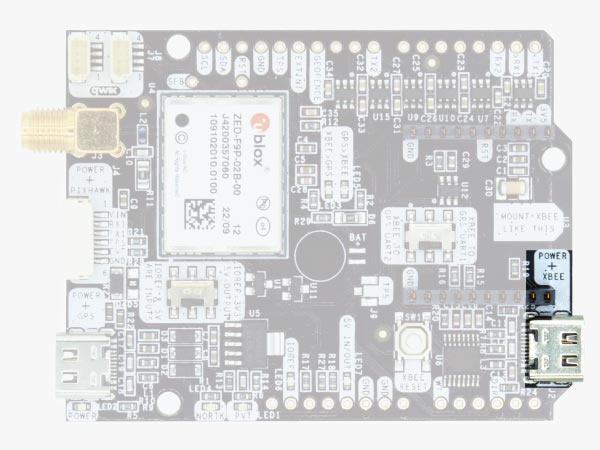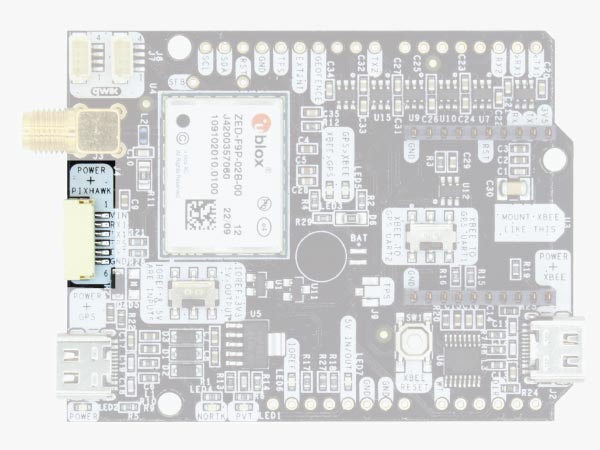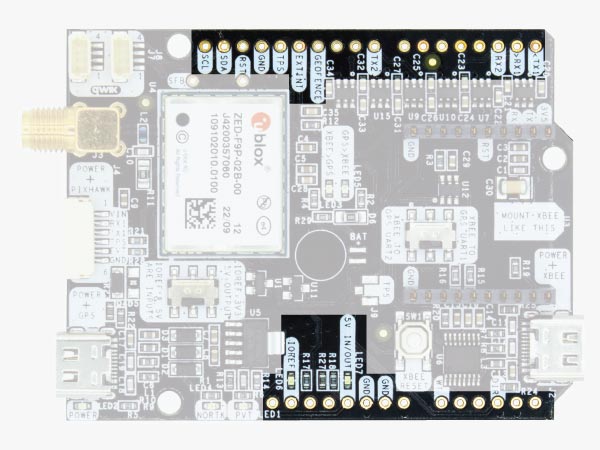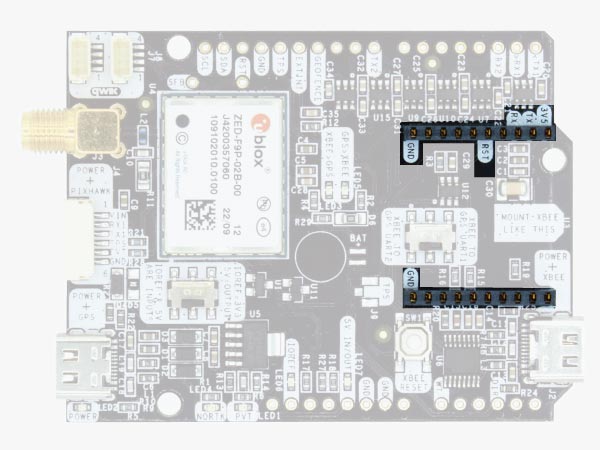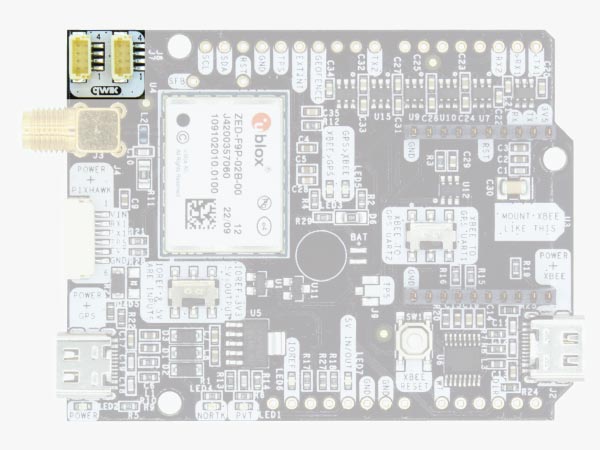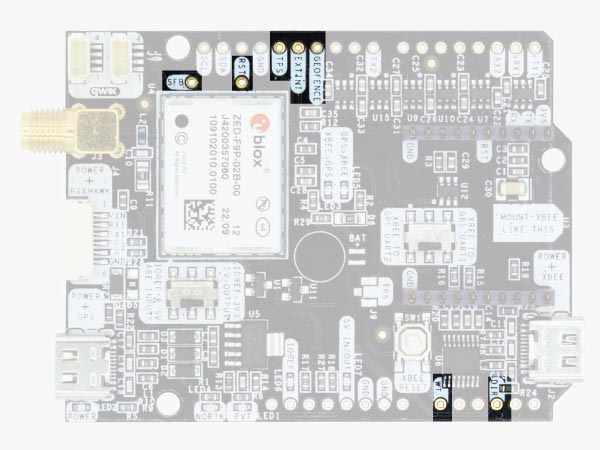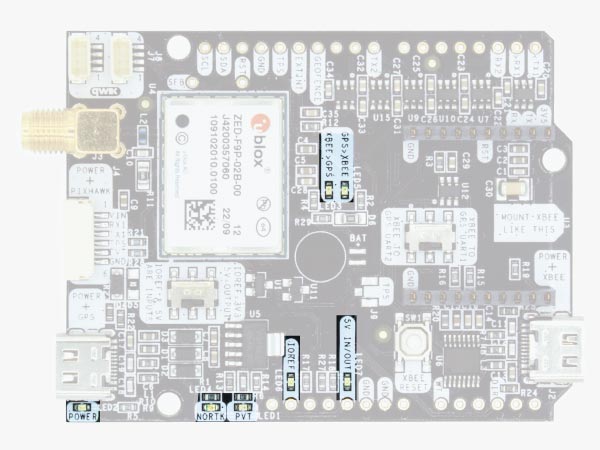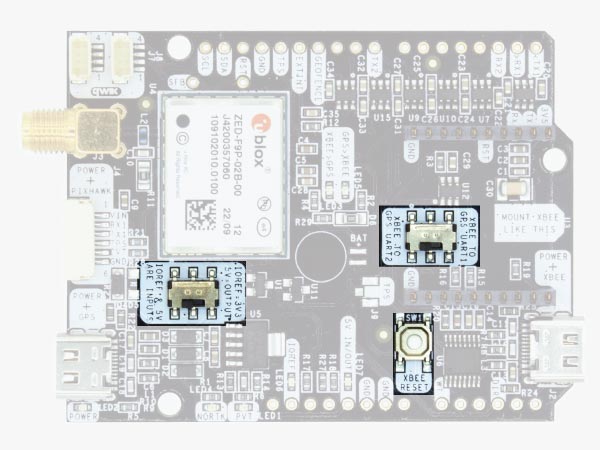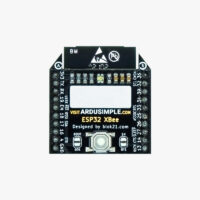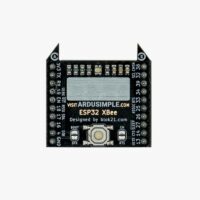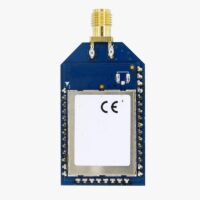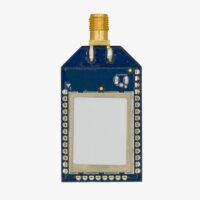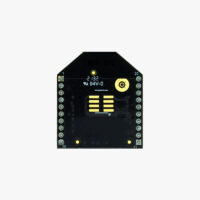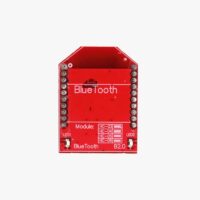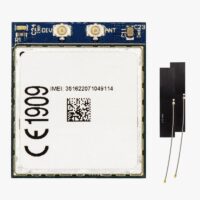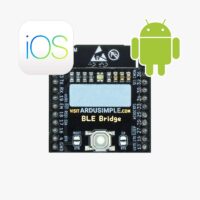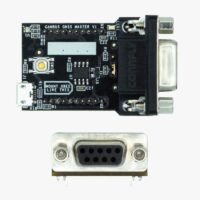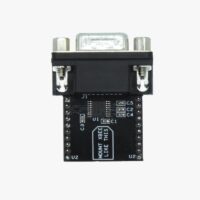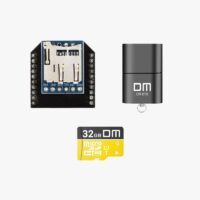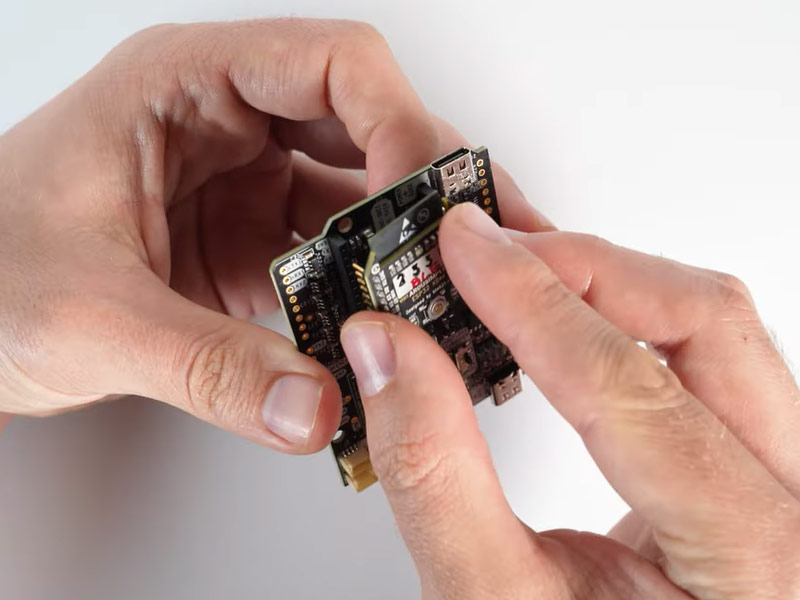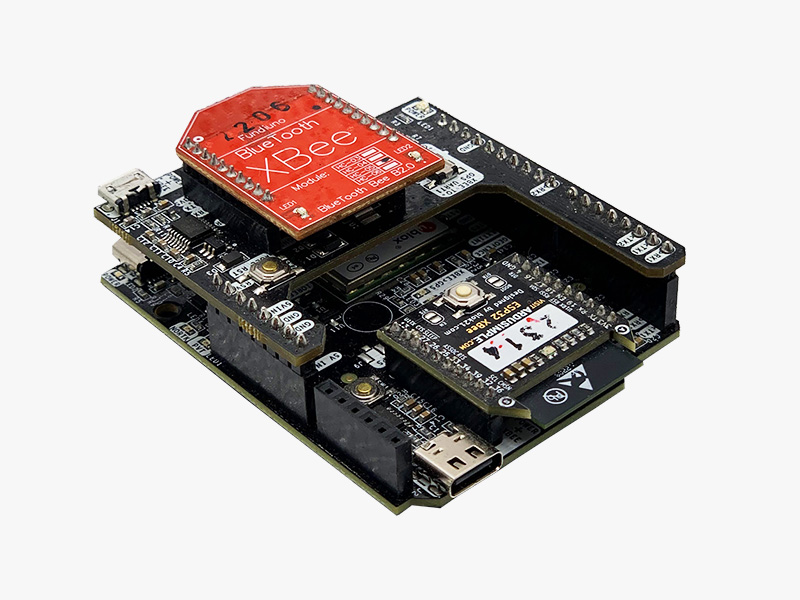User Guide: simpleRTK2B Pro
Product overview
You can use the simpleRTK2B Pro as a standalone board or as an Arduino shield.
The main component of the simpleRTK2B Pro is the u-blox ZED-F9 module, which comes in 2 variants:
- ZED-F9P RTK GNSS module: Advanced u-blox GPS users can refer to its extensive u-blox documentation.
- ZED-F9R RTK GNSS + Sensor Fusion module: This product is for advanced u-blox GPS users, you will find more information directly from the manufacturer documentation.
Get started
Step A: Connect antenna
- Connect the GNSS antenna to your receiver.
- Place GNSS antenna outdoors in a place with a good view of the sky for testing functionality. Otherwise, you won’t see the satellite view and signal.
Step B: Connect to PC and u-center
U-center is an evaluation software designed for assessing, analyzing performance, and configuring u-blox GNSS positioning chips and modules. Follow our quick guide to start.- Connect the receiver to your PC via the USB port labelled as POWER+GPS using USB cable.
- Open u-center (for F9, not u-center2). Select the COM port to connect your receiver. If you don’t know which COM port your receiver is connected, check the Device Manager of your PC.
- In the views toolbar, you can choose the data you want to visualize. We recommend to enable GPS data and Satellite levels to check the coordinates and signal strength.
Step C: RTK corrections
In order to achieve centimeter/millimeter level accuracy with our GNSS receivers, you need to have RTK corrections. The easiest way to get RTK corrections is to use an RTK correction service available in your country. We have prepared a list of RTK correction services in your country to help you get started.
Before you start:
- You registered to the RTK correction service and received credentials (server address, port, user and password) to connect to it.
- Your PC has internet connection in order to connect to NTRIP service.
- At menu bar go to Receiver–>NTRIP Client… and set up the Address, Port, Username, Password and Mount point of your NTRIP. Click OK.
- In a few minutes, you will see the Fix Mode change to FIXED or FLOAT. With valid FIXED you should see the 3D Acc.(accuracy) and 2D Acc.(accuracy) is centimeter-level.
If you need additional information, such as upgrading firmware, configuring the receiver as a base or rover, or connecting to communication plugins like Bluetooth and radio, please refer to the simpleRTK2B configuration page.
Hardware
Pinout
Power
The simpleRTK2B Pro board can be powered from 4 different sources:
- GPS USB port
- XBEE USB port
- Pixhawk connector
- Arduino rail
Only one source is needed to power the board. You can connect all of them simultaneously without any risk.
With the simpleRTK2B Pro, we introduce the new High-Power (HP) XBee socket. If you connect a high-power device to this socket, ensure your power supply can provide the required power.
- Use only high-quality USB-C cables no longer than 1 meter.
- If you connect the simpleRTK2B Pro through a low-power USB hub or to a PC with low-power USB ports, you must connect the second USB port directly to a wall plug or a high-power USB port.
GNSS Antenna
The simpleRTK2B Pro receiver requires a high-quality GPS/GNSS dual band antenna, and using it with a traditional cheap GPS antenna will not achieve the expected performance.
The board is compatible with both active antennas (maximum output is 75mA @ 3.3V) and passive antennas.
Installation Notes:
- Always connect the antenna before powering the board. This is very important as some board components could overheat if no antenna is connected.
- Screw the antenna to the SMA connector by hand, never use any tools. You could break the connectors if too much force is applied.
- Install the antenna with the clearest possible view of the sky. Use it outdoors and as far as possible from surrounding buildings, mountains.
- For best results, install the antenna on top of a metallic flat plate of at least 20cm side lenght (e.g. a car top surface).
For more information on how antenna installation impacts performance, see our GPS/GNSS antenna installation guide.
Interfaces
USB GPS
This USB-C connector gives you access to the native USB port of the ZED-F9P receiver.
You can receive NMEA position data or gain full access to the receiver using the u-center software.
You can connect this interface to a mobile phone, tablet, or PC to start receiving NMEA data.
Driver Information:
- Windows 10: No drivers are needed.
- Windows 7/8: If you experience problems, try the alternative driver available here: zed-ubloxusb.zip.
- Mobile: You can also connect this USB port to your mobile phone or tablet using an OTG cable.
USB XBee
This USB-C connector provides access to the UART of the XBEE radio module (if you installed one) via an FTDI USB-to-UART converter.
We find very practical to use this connector to power the board, so you can then connect or disconnect the GPS USB at will without removing power from the board.
- For Power Only: No driver is needed and you just need a standard USB wall plug adapter.
- For Configuring XBee Radio: You will need the VCP driver from FTDI: FTDI VCP Drivers.
Pixhawk connector
This is a standard JST GH connector that can be used to connect the simpleRTK2B Pro to a Pixhawk autopilot.
You can also use this connector to power the board.
The Pixhawk JST-GH connector is following the Pixhawk standard:
- 1: 5V_IN
- 2: ZED-F9P UART1 RX (3.3V level)
- 3: ZED-F9P UART1 TX (3.3V level)
- 4: Timepulse output (3.3V level)
- 5: EXTINT input (3.3V level)
- 6: GND
In case you want to build a custom cable for this the specific mating aerial connector is a JST GHR-06V.
Please note that the board only provides GNSS positioning and doesn’t include a magnetometer.
Arduino rails
The simpleRTK2B Pro has optional rails to connect to any Arduino UNO compatible device.
- GND: Ground is available on the standard Arduino pins. You should always connect this line to your other board.
- 5V IN/OUT:
- When the LED next to this pin is OFF, can power simpleRTK2B Pro from this pin (e.g., by plugging it into an Arduino UNO).
- To use the simpleRTK2B Pro to power another shield, turn the 5V=OUTPUT switch ON. The board will then output 5V from this pin.
- IOREF: This pin defines the voltage level for the communication pins TX1,RX1,TX2,RX2,SDA and SCL.
- When plugged to an Arduino UNO or Raspberry Pi, this pin is used to automatically define the voltage level at the listed pins.
- When wiring your own cables to the board, the input voltage in the pin will define the voltage level at the listed pins. It supports from 1.2V up to 5.5V.
- If 3.3V is a valid voltage at the above listed pins for your application, just turn ON the IOREF=3.3V switch.
- TX1,RX1,TX2,RX2,SDA,SCL: These pins work with the voltage level defined by IOREF.
- TX1: ZED-F9P UART1 TX.
- RX1: ZED-F9P UART1 RX.
- RX2: ZED-F9P UART2 RX (this pin is also connected to XBee UART TX).
- TX2: ZED-F9P UART2 TX (this pin is also connected to XBee UART RX).
- SDA: ZED-F9P i2C SDA.
- SCL: ZED-F9P I2C SCL.
High Power (HP) XBee socket
With the simpleRTK2B Pro we introduce the new High Power (HP) XBee socket.
You can use this socket to connect to a compatible XBee radio. The following pins are available:
- VCC, 3.3V output with a maximum supported current of 1A constant and peaks of 1.5A.
- XBee UART RX, at 3.3V level
- XBee UART TX, at 3.3V level
- GND
This interface is connected to the ZED-F9P UART ports. Use the switch in-between the XBee interface rails to choose the port used, whether UART1 or UART2.
Qwiic connectors
If you already own a Sparkfun Qwiic accesory, you can use it with the simpleRTK2B Pro.
However, due to high power requirements in some configurations, the board cannot be powered from the Qwiic connector.
When connecting Qwiic accesories:
- Power simpleRTK2B Pro from one of the 4 power sources: USB GPS, USB XBEE, 5V INPUT, or Pixhawk.
- Turn the board switch to IOREF & 5V ARE INPUTS to allow the Qwiic accesory to set the voltage of the IOREF communication pins.
If you want to build a custom cable to connect a Qwiic accesory the mating connector is a JST SHR-04V.
Special function pins
In addition to the above, there’s also a few additional Special Function Pins available for the most advanced users.
If you are going to use simpleRTK2B Pro connected to an Arduino or Raspberry Pi and you will not use any of these Special Function pins, it is recommended not to connect these pins. You can cut the header on these pins to prevent unexpected behavior.
- Timepulse (TPS): 3.3V configuration time pulse output.
- Extint (EXTINT): Time synchronization input with a maximum voltage of 3.6V.
This input is filtered to avoid glitches. - Geofence (GEOFENCE): geofence in-out pin from ZED-F9P.
- Safeboot (SF)
- Reset_N (RST)
- Wheeltick (WT): only available for the ZED-F9R variant.
- Direction (DIR): only available for the ZED-F9R variant.
To learn more about these pins, we recommend reading the ZED-F9P documentation.
LEDs
The board includes 7 status LEDs:
- POWER: Indicates that the board has power.
- PVT: Lights up when a position has been calculated from available satellites view.
- NO RTK: Uses the u-blox default configuration for the RTK_STAT pin. OFF with RTK fix status, blinking when receiving RTCM data, ON when no corrections are applied. (This LED is red).
- XBEE>GPS: The XBEE radio is receiving data over the air and sending it to the ZED-F9P module.
- GPS>XBEE: The ZED-F9P module outputs data to the XBEE radio, which is sending it over the air.
- 5V IN/OUT: Indicates that there is voltage on that pin.
- IOREF: Indicates that the IOREF pin is enabled and controlling associated pins voltage.
Buttons and switches
- XBee Reset Button: Used for programming XBee radio modules (e.g. firmware updates). You will likely never need to use it.
- XBee socket switch: Selects which ZED-F9P receiver UART (UART1 or UART2) is connected to the XBee socket.
- IOREF & 5V IN/OUT switch: Indicates whether the IOREF and 5V Arduino rail pins are set as INPUTS or OUTPUTS. In the second case the simpleRTK2B Pro board can be used to power external accessories like the Shield for a Second XBee socket.
Accessories
You can add extra functionality to your simpleRTK2B Pro board by using one of our plugins connected to the XBee socket.
-
Plugins
Radio module Long Range (LR)
101,00€ This product has multiple variants. The options may be chosen on the product page -
Plugins
Radio module eXtra Long Range (XLR)
161,00€ This product has multiple variants. The options may be chosen on the product page -
Sale!
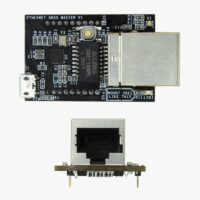 Made in Europe
Made in Europe -
Plugins
4G NTRIP Master
156,00€ This product has multiple variants. The options may be chosen on the product page
How to add plugin
- To connect the communication plugin to the XBee socket, simply insert it into the XBee connector on the board.
- To use the plugin, go to the u-blox ZED-F9P configuration page and load the configuration file Send NMEA messages to communication plugin onto your receiver following the instructions.
- The board supports a second XBee plugin. You can use two communication plugins at the same time by adding a Shield for Second Plugin Socket. To attach it, you will need the Expansion Headers Kit (not soldered) on the receiver, or order Expansion Headers Kit (soldered) if you want us to solder it for you.
-
Sale!
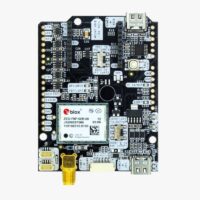 Made in EuropeRTK2B Boards
Made in EuropeRTK2B BoardssimpleRTK2B Pro
From 165,00€ This product has multiple variants. The options may be chosen on the product page
 and
and 

